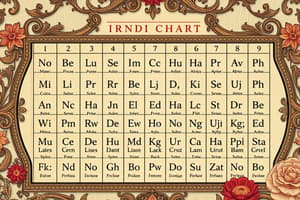Podcast
Questions and Answers
What does the International Phonetic Alphabet (IPA) represent?
What does the International Phonetic Alphabet (IPA) represent?
- The sounds of spoken language (correct)
- The meaning of words in language
- Only vowel sounds of language
- Only consonant sounds of language
Voiceless sounds do not involve vibration of the vocal cords.
Voiceless sounds do not involve vibration of the vocal cords.
True (A)
What are the three main characteristics that IPA symbols describe in vowels?
What are the three main characteristics that IPA symbols describe in vowels?
Height, Backness, Roundedness
IPA diacritics are used to modify the sounds represented by IPA symbols, such as indicating ______ or stress.
IPA diacritics are used to modify the sounds represented by IPA symbols, such as indicating ______ or stress.
How is stress indicated in IPA notation?
How is stress indicated in IPA notation?
Length refers only to the phonemic duration of sounds in speech.
Length refers only to the phonemic duration of sounds in speech.
What is the purpose of intonation in speech?
What is the purpose of intonation in speech?
In tonal languages, ______ affects the meaning of words.
In tonal languages, ______ affects the meaning of words.
Which of the following represents a method to classify consonant sounds in IPA?
Which of the following represents a method to classify consonant sounds in IPA?
Match the following IPA attributes with their definitions:
Match the following IPA attributes with their definitions:
Flashcards are hidden until you start studying
Study Notes
IPA Symbols
- Definition: The International Phonetic Alphabet (IPA) is a system of phonetic notation that provides a standardized set of symbols to represent the sounds of spoken language.
- Consonants:
- Voicing: Symbols distinguish between voiced (vocal cords vibrating) and voiceless sounds (no vibration).
- Place of Articulation: Symbols indicate where in the vocal tract the sound is produced (e.g., bilabials, alveolars, velars).
- Manner of Articulation: Symbols describe how the airflow is constricted (e.g., stops, fricatives, nasals).
- Vowels:
- Height: Symbols represent the vertical position of the tongue (high, mid, low).
- Backness: Symbols indicate the horizontal position of the tongue (front, central, back).
- Roundedness: Symbols mark whether the lips are rounded or unrounded during vowel production.
- Diacritics:
- Additional marks that modify the sounds represented by IPA symbols (e.g., nasalization, length, stress).
Suprasegmental Features
- Definition: Features that extend beyond individual sounds (segments) and include aspects of speech such as intonation, stress, and rhythm.
- Stress:
- Refers to the emphasis placed on certain syllables or words in speech.
- Marked in IPA with a vertical line before the stressed syllable (e.g., ˈcom·pu·ter).
- Intonation:
- The variation in pitch while speaking, often used to convey meaning or emotion.
- Can indicate questions, statements, or commands through rising and falling pitch patterns.
- Length:
- Refers to the duration of sounds, which can be phonemic (changing meaning) or non-phonemic (not changing meaning).
- Long sounds are often indicated in IPA with a colon (:) or a diacritic.
- Tone:
- Used in tonal languages where pitch affects meaning of words.
- Tone is marked in IPA to indicate the pitch contour associated with a syllable.
IPA Symbols
-
The International Phonetic Alphabet (IPA) offers a standardized symbol system for representing spoken language sounds.
-
Consonants:
- Voicing distinguishes between voiced sounds (with vocal cord vibration) and voiceless sounds (without vibration).
- Place of Articulation indicates where sounds are produced in the vocal tract, such as bilabials (lips), alveolars (tongue against the alveolar ridge), and velars (back of the tongue against the soft palate).
- Manner of Articulation describes the type of airflow constriction, including stops (complete closure), fricatives (partial closure), and nasals (airflow through the nose).
-
Vowels:
- Height identifies the vertical position of the tongue during articulation (high, mid, low).
- Backness reflects the horizontal position of the tongue (front, central, back).
- Roundedness denotes whether the lips are rounded (e.g., [u]) or unrounded (e.g., [i]) during vowel sound production.
-
Diacritics:
- These are additional marks that modify IPA symbols to represent nuances like nasalization, sound length, or word stress.
Suprasegmental Features
-
Suprasegmental features are speech aspects that extend beyond individual sounds, including intonation, stress, and rhythm.
-
Stress:
- Emphasis is placed on certain syllables or words; denoted in IPA with a vertical line before the stressed syllable (e.g., ˈcom·pu·ter).
-
Intonation:
- Involves variations in pitch while speaking, used to express emotions or convey different meanings. Rising and falling pitch patterns signify questions, statements, or commands.
-
Length:
- Refers to sound duration, which can impact meaning (phonemic) or be non-meaning altering (non-phonemic). Long sounds are indicated by a colon (:) or specific diacritics in IPA.
-
Tone:
- Present in tonal languages, where pitch variations directly affect word meanings; marked in IPA to represent the pitch contour of a syllable.
Studying That Suits You
Use AI to generate personalized quizzes and flashcards to suit your learning preferences.




